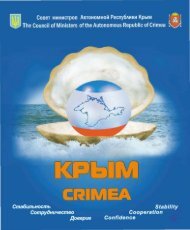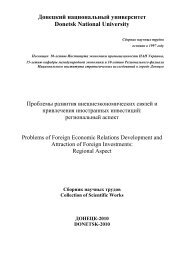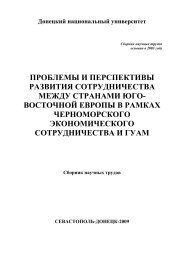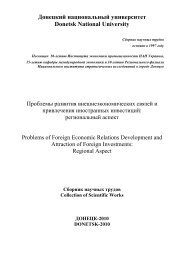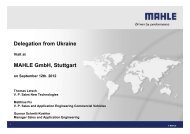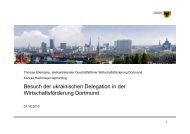Проблемы развития внешнеэкономических связей и привлечения иностранных инвестиций: региональный аспект, 2010PROJECT MANAGEMENT- EAST VS WESTTannyan Neil Jeffrey, Masters of Applied Science, Professional Engineer of Ontario, Project Manager, Hatch (Canada) ⋅IntroductionThe purpose of this paper is to explain Project Development Processes in the East (CIS countries) vs the West. Each method will be explained, and differencesnoted along with advantages and disadvantages. Some case studies and examples will be reviewed. The advantages of using a Professional ProjectManagement Company will also be reviewed.Eastern SchemeIt should be noted that the process described below is based on the writers current experience and that of their company, working specifically with theUkrainian Steel Industry, and is not necessarily representative of other industries within the Ukraine. The writer’s company has conducted several detailedaudits of failed projects for financing companies over the past 5 years in the Ukraine and Russia.The project development process currently used is based on the process that was used in the former Soviet Union, with a heavy focus on the formerly stateowned Design Institutes. The Design Institutes provided approvals for projects, along with the engineering and project capital cost estimates. The institutes stillexist as privately owned companies; however in many cases they have not updated their engineering techniques and procedures to match world standardpractices. This will be explained in further detail. The design institutes merely prepare documentation, but are not involved in actual project implementation.The Eastern process is shown in Figure 1. The process begins with a concept or idea from the plant. They have a very general cost of the equipment or process,approximately +/-50%. The design institute then prepares at TEO- Technical and Economic Report which is issued to the plant (but is still property of thedesign institute).The TEO includes a capital cost estimate that is accurate to approximately +/- 20%. The cost estimate is developed based on the historic published nationalbook of costs for facilities and materials of similar equipment that was installed as long as 30 years ago. An inflation factor is used to estimate the value attoday’s costs. However there are no actual quotations used in these cost estimates, and based on the type of technology, and in particular the material costs forthe equipment, the old prices are very inaccurate. The main equipment supplier has not been selected at the TEO stage, of which typically about 40-50% of thecosts will be attributed to, leaving this as a major weak point.In addition, the construction costs are also estimate using factors provided by the state, and do not take into account best construction practices (for examplequick setting concrete, plasma torches, etc). The labor, equipment, raw material and construction company costs are all estimates. In addition, the estimates alsolack several key factors as was found during a detailed examination, these include but are not limited to spare parts, first fills of oils/greases, commissioningand training costs, shipping costs, technology integration, etc.It should be noted that the TEO does not provide a detailed construction schedule and there is very little basic engineering that has been performed at this stage.The TEOs also include a staffing estimate, but it has been found that these are 2-3 times higher than in Western operations. In addition, key items such as thelife of the equipment are missing.The TEO is used by the plants as the basis for the Final Investment Decision (FID). However, at this stage there is no detailed schedule, little basic engineeringand no detailed implementation plan. However the project budget was approved by Management based on this documentation. Therefore, there is very highrisk that the budget will increase and the project will not be completed on time.After FID, the Design Institute then prepares a stage called detailed design, with an estimate budget of +/-10%. However, during investigations it was foundthis number is closer to +/- 20%. The overall project plan is not updated with this new cost. The detailed design is used to obtain the construction and operatingpermits from UKRINVESTEXPERTIZA. It should be noted that the company has audited projects where no approval documentation can be found, yet theconstruction was completed.Figure 1- Eastern Project Development SchematicFollowing the approval stage, the detailed construction and engineering drawings are completed. A general contractor is selected for the construction. Howeverthe contracts with the contractors are not usually “LUMP SUM” as in the west, but are based on labor rates and hours worked. Thus there is no real incentivefor the contractor to work quickly and efficiency. Many contracts in the West include a BONUS for early completion and are based on a LUMP SUM / fixedcost.In addition, in many cases there is no project manager or Project Management Company responsible for the coordination and overall success of the project.Example a failed project using the Eastern SchemeListed below is the summary of a major project reviewed by the writers company.© Tannyan Neil Jeffrey, 201054
Проблемы развития внешнеэкономических связей и привлечения иностранных инвестиций: региональный аспект, 2010• The project was 204% over budget• The project was delivery 1.5 years late.• The equipment installed will produce 25% less steel than it was designed for.• Items were added to the scope of the project but the management team were not notified.• No actual start date for production was included in the initial plan.• No one had overall responsibility for the project which led to a lot of finger pointing.• Unrealistic numbers were used in the budget preparation- old labor rates, incorrect prices for raw materials and equipment, estimates of taxes andduties were incorrect.East Scheme ConclusionsThe following a major shortcomings of the East Process• Lack of clear definition of the technical elements of the project• Lack of accurate project cost estimate and detailed control budget• Lack of integrated project schedule• Lack of good project management controls and procedures during projectimplementation.Western ProcessThe process used by many major corporations focuses on conducting a significant amount of engineering, planning and scheduling prior to the FID in order todevelop an accurate project plan. The specific name of the process used at Hatch is the Front End Loading (FEL) process, and is based on the significantplanning and engineering conducted in the early project stages. It should be noted that the term FEL is specific to Hatch, and many companies have differentnames for the process, but the processes are fundamentally the same.The FEL process is divided into 4 stages as shown in Figure 2. At the end of each stage, the following is required:• A checklist of all documentation required, is reviewed and signed off by a review team. The documentation includes safety studies, environmentalstudies, technical documents, logistics studies, construction plans, project schedules and cost estimate documentation. The amount of detail on the checklistincreases with each FEL stage.• The funds required to proceed with each subsequent stage are also approved prior to that FEL stage commencing. This allows management toclearly identify the costs associated with the project, and decide up front if they want to spend money to develop the project. It also allows companies to stop aproject in the early stages if it is not feasible, without spending the funds required to bring the project to FID. Sometimes the best thing that can be done for aproject is stop it early, if it is genuinely not feasible.• A detailed capital cost estimate along with a project justification (financial model) assesses the project’s feasibility. The project payback period iscalculated as well as operating costs and profit margins. The project viability is reviewed by the appropriate financial personnel.• The final approval to proceed to the next stage is made by senior management. The level of management required for the decision depends on thesize and scope of the project.Figure 2- Western Project Development SchemeFEL 1 StageListed below are key Characteristics of the FEL 1 Stage. The goal of the FEL 1 stage is develop a high level project concept to determine if the idea for theproject is feasible.• Commonly known as Conceptual Study• Capital cost estimate +/- 30%• Use of past experience to select technology to be used• High Level Review of Risks, Safety and Environmental impact• Selection of plant location• Development of Project Organization Chart• List potential suppliers and available technologies• High level life-cycle review of technology• Development of Quality Control Plan55
- Page 1 and 2:
Донецкий националь
- Page 3 and 4: Редакционная колле
- Page 5 and 6: Проблемы развития
- Page 7 and 8: Проблемы развития
- Page 10 and 11: Проблемы развития
- Page 12 and 13: 12Проблемы развития
- Page 14 and 15: Проблемы развития
- Page 16 and 17: Проблемы развития
- Page 18 and 19: 18Проблемы развития
- Page 20 and 21: Проблемы развития
- Page 22 and 23: Проблемы развития
- Page 24 and 25: Проблемы развития
- Page 26 and 27: 26Проблемы развития
- Page 28 and 29: Проблемы развития
- Page 30 and 31: Проблемы развития
- Page 32 and 33: Проблемы развития
- Page 34 and 35: Проблемы развития
- Page 37 and 38: Проблемы развития
- Page 40 and 41: 40Проблемы развития
- Page 42 and 43: Проблемы развития
- Page 44 and 45: Проблемы развития
- Page 46 and 47: 46Проблемы развития
- Page 48 and 49: 48Проблемы развития
- Page 50 and 51: Проблемы развития
- Page 52 and 53: Проблемы развития
- Page 56 and 57: 56Проблемы развития
- Page 58 and 59: Проблемы развития
- Page 60 and 61: РКрим А і н ницькаВ
- Page 62 and 63: Проблемы развития
- Page 64 and 65: содействия поФондМ
- Page 66 and 67: Проблемы развития
- Page 68 and 69: 68Проблемы развития
- Page 70 and 71: 70Проблемы развития
- Page 72 and 73: Проблемы развития
- Page 74 and 75: Проблемы развития
- Page 76 and 77: 76Проблемы развития
- Page 78 and 79: 78Проблемы развития
- Page 80 and 81: 80Проблемы развития
- Page 82 and 83: Проблемы развития
- Page 84 and 85: 84Проблемы развития
- Page 86 and 87: Проблемы развития
- Page 88 and 89: Проблемы развития
- Page 90 and 91: Проблемы развития
- Page 92 and 93: Проблемы развития
- Page 94 and 95: Проблемы развития
- Page 96 and 97: Проблемы развития
- Page 98 and 99: 98Проблемы развития
- Page 100 and 101: Проблемы развития
- Page 102 and 103: 102Проблемы развити
- Page 104 and 105:
Проблемы развития
- Page 106 and 107:
Проблемы развития
- Page 108 and 109:
Проблемы развития
- Page 110 and 111:
Проблемы развития
- Page 112 and 113:
Проблемы развития
- Page 114 and 115:
60000700004000050000200003000001000
- Page 116 and 117:
Проблемы развития
- Page 118 and 119:
Проблемы развития
- Page 120 and 121:
Проблемы развития
- Page 122 and 123:
Проблемы развития
- Page 124 and 125:
Проблемы развития
- Page 126 and 127:
Проблемы развития
- Page 128 and 129:
01 ж ивi тварини55 хiмi
- Page 130 and 131:
Проблемы развития
- Page 132 and 133:
Проблемы развития
- Page 134 and 135:
Проблемы развития
- Page 136 and 137:
136Проблемы развити
- Page 138 and 139:
Проблемы развития
- Page 140 and 141:
Проблемы развития
- Page 142 and 143:
Проблемы развития
- Page 144 and 145:
Проблемы развития
- Page 146 and 147:
Проблемы развития
- Page 148:
Проблемы развития
- Page 151 and 152:
Проблемы развития
- Page 153 and 154:
Проблемы развития
- Page 155 and 156:
Проблемы развития
- Page 157 and 158:
Проблемы развития
- Page 159 and 160:
Проблемы развития
- Page 161 and 162:
Проблемы развития
- Page 163 and 164:
Проблемы развития
- Page 165 and 166:
Проблемы развития
- Page 167 and 168:
Проблемы развития
- Page 169 and 170:
Проблемы развития
- Page 171 and 172:
Проблемы развития
- Page 173 and 174:
Проблемы развития
- Page 175 and 176:
Проблемы развития
- Page 177 and 178:
Проблемы развития
- Page 179 and 180:
Проблемы развития
- Page 181 and 182:
Проблемы развития
- Page 183 and 184:
Проблемы развития
- Page 185 and 186:
Проблемы развития
- Page 187 and 188:
Проблемы развития
- Page 189 and 190:
Проблемы развития
- Page 191 and 192:
Проблемы развития
- Page 193 and 194:
Проблемы развития
- Page 195 and 196:
Проблемы развития
- Page 197 and 198:
Проблемы развития
- Page 199 and 200:
Проблемы развития
- Page 201 and 202:
Проблемы развития
- Page 203 and 204:
4748,14039,3Проблемы раз
- Page 205 and 206:
Проблемы развития
- Page 207 and 208:
Проблемы развития
- Page 209 and 210:
Проблемы развития
- Page 211 and 212:
Проблемы развития
- Page 213 and 214:
Проблемы развития
- Page 215 and 216:
Проблемы развития
- Page 217 and 218:
Проблемы развития
- Page 219 and 220:
Проблемы развития
- Page 221 and 222:
Проблемы развития
- Page 223 and 224:
Проблемы развития
- Page 225 and 226:
Проблемы развития
- Page 227 and 228:
Проблемы развития
- Page 229 and 230:
Проблемы развития
- Page 231 and 232:
Проблемы развития
- Page 233 and 234:
Проблемы развития
- Page 235 and 236:
Проблемы развития
- Page 237 and 238:
Проблемы развития
- Page 239 and 240:
Проблемы развития
- Page 241 and 242:
⌢Проблемы развити
- Page 243 and 244:
Проблемы развития
- Page 245 and 246:
Проблемы развития
- Page 247 and 248:
Проблемы развития
- Page 249 and 250:
Проблемы развития
- Page 251 and 252:
Проблемы развития
- Page 253 and 254:
Проблемы развития
- Page 255 and 256:
Проблемы развития
- Page 257 and 258:
Проблемы развития
- Page 259 and 260:
Проблемы развития
- Page 261 and 262:
Проблемы развития
- Page 263 and 264:
Проблемы развития
- Page 265 and 266:
Проблемы развития
- Page 267:
−−−−Проблемы раз
- Page 270:
Проблемы развития
- Page 273 and 274:
Проблемы развития
- Page 275 and 276:
Проблемы развития
- Page 277 and 278:
Проблемы развития
- Page 279 and 280:
Проблемы развития
- Page 281 and 282:
Проблемы развития
- Page 283 and 284:
Проблемы развития
- Page 285 and 286:
Проблемы развития
- Page 287 and 288:
Проблемы развития
- Page 289 and 290:
Проблемы развития
- Page 291 and 292:
Проблемы развития
- Page 293 and 294:
Проблемы развития
- Page 295 and 296:
Проблемы развития
- Page 297 and 298:
Проблемы развития
- Page 299 and 300:
Проблемы развития
- Page 301 and 302:
Проблемы развития
- Page 303 and 304:
Проблемы развития
- Page 305 and 306:
Проблемы развития
- Page 307 and 308:
Проблемы развития
- Page 309 and 310:
Проблемы развития
- Page 311 and 312:
Проблемы развития
- Page 313 and 314:
Проблемы развития
- Page 315 and 316:
Проблемы развития
- Page 317 and 318:
Проблемы развития
- Page 319 and 320:
Проблемы развития
- Page 321 and 322:
Проблемы развития
- Page 323 and 324:
Проблемы развития
- Page 325 and 326:
Проблемы развития
- Page 327 and 328:
Проблемы развития
- Page 329 and 330:
Проблемы развития
- Page 331 and 332:
Проблемы развития
- Page 333 and 334:
Проблемы развития
- Page 335 and 336:
Проблемы развития
- Page 337 and 338:
Проблемы развития
- Page 339 and 340:
Проблемы развития
- Page 341 and 342:
Проблемы развития
- Page 343 and 344:
Проблемы развития
- Page 345 and 346:
Проблемы развития
- Page 347 and 348:
Проблемы развития
- Page 349 and 350:
Проблемы развития
- Page 351 and 352:
Проблемы развития
- Page 353 and 354:
РАЗВИТИЕ ВНЕШНЕЭКО
- Page 355 and 356:
Морозова О.В. ДИСБА
- Page 357 and 358:
УКРАИНЕШумак Ж.Г.ПР
- Page 359 and 360:
КРИЗИВорошилова Г.
- Page 361 and 362:
Именной указатель/
- Page 363 and 364:
Костенко Н.В. 1 71Кош
- Page 365 and 366:
Ступницький О.І. 3 784





